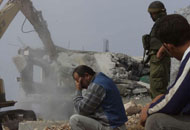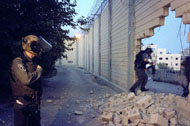KEY PRINCIPLES
I. Overview
Israel is committed to the peace process, and aspires to reach amutual agreement on the basis of two states for two peoples, the State of Israel as the state of the Jewish people and a Palestinianstate for the Palestinian people, as part of the realization of US President George W. Bush's vision.
Israel believes that it must act to improve the current reality.Israel has come to the conclusion that at present, there is no Palestinian partner with whom it is possible to make progress on a bilateral agreement. In light of this, a unilateral disengagement plan has been formulated, which is based on the following considerations:
A. The stagnation inherent in the current situation is harmful. In order to emerge from this stagnation, Israel must initiate a move that will not be contingent on Palestinian cooperation.
B. The plan will lead to a better security reality, at least in the long term.
C. In any future final-status agreement, there will be no Israeli settlement in the Gaza Strip. However, it is clear that in Judea and Samaria, some areas will remain part of the state of Israel, among them civilian settlements, military zones and places where Israel has additional interests.
D. The exit from the Gaza Strip and from the area of northern Samaria (four settlements and military installations in their environs) will reduce friction with the Palestinian population and has the potential to improve the fabric of Palestinian life and thePalestinian economy.
E. Israel hopes that the Palestinians will have the sense to take advantage of the disengagement move in order to exit the cycleof violence and rejoin the process of dialogue.
F. The disengagement move will obviate the claims about Israel with regard to its responsibility for the Palestinians in the Gaza Strip.
G. The disengagement move does not detract from the existing agreements between Israel and the Palestinians. The existing arrangements will continue to prevail.
When there is evidence on the Palestinian side of the willingness, ability and actual realization of a fight against terror and of the implementation of the reforms stipulated in the roadmap, it will be possible to return to the track of negotiationsand dialogue.
MAIN POINTS OF THE PLAN
A. The Gaza Strip
1. Israel will evacuate the Gaza Strip, including all the Israeli settlements currently existing there, and will redeploy outside the territory of the Strip. This, apart from military deployment along the border line between the Gaza Strip and Egypt, will be detailed below.
2. Upon completion of the move, no permanent Israeli civilian ormilitary presence in the areas that are evacuated in the continental expanse of the Gaza Strip will remain. As a result, there will be no basis for the claim that the Gaza Strip is occupied territory.
B. Judea and Samaria
1. Israel will evacuate the area of northern Samaria (Ganim, Kadim, Homesh and Sa-Nur) and all the permanent military installations in this area, and will redeploy outside the evacuatedarea.
2. Upon completion of the move, no permanent presence of Israelimilitary forces and Israeli civilians in the area of northern Samaria will remain.
3. The move will enable Palestinian territorial contiguity in the area of northern Samaria.
4. Israel will improve the transportation infrastructure in Judea and Samaria with the aim of enabling Palestinian transportation contiguity in Judea and Samaria.
5. The move will make Palestinian economic and commercial activity easier in Judea and Samaria.
C. The security fence
Israel will continue to build the security fence, in accordance with the relevant government decisions. The route will take humanitarian considerations into account.
SECURITY REALITY AFTER THE EVACUATION
A. The Gaza Strip
1. Israel will supervise and guard the external envelope on land, will maintain exclusive control in the air space of Gaza, and will continue to conduct military activities in the sea space of the Gaza Strip.
2. The Gaza Strip will be demilitarized and devoid of armaments,the presence of which is not in accordance with the existing agreements between the sides.
3. Israel reserves for itself the basic right of self-defense, including taking preventative steps as well as responding by using force against threats that will emerge from the Gaza Strip.
B. Judea and Samaria
1. Upon evacuation of the settlements from northern Samaria (Ganim, Kadim, Homesh and Sa-Nur), no permanent military presence will remain in their environs.
2. Israel reserves for itself the basic right of self-defense, including taking of preventative steps as well as responding with force against threats that emerge from this area.
3. In the rest of the Judea and Samaria territories, existing security activity will continue. However, in accordance with the circumstances, Israel will consider reducing its activity in Palestinian cities.
4. Israel will work toward reducing the number of checkpoints in Judea and Samaria as a whole.
MILITARY INSTALLATIONS, INFRASTRUCTURES IN THE GAZA STRIP AND THE NORTHERN SAMARIA AREA
In general, they will be dismantled and evacuated, except for those that Israel will decide to leave in place and transfer to a body that will be determined.
THE NATURE OF MILITARY AID TO THE PALESTINIANS
Israel agrees that, in coordination with it, advice, aid and instruction will be given to Palestinian security forces for the purpose of fighting terror and maintaining public order by American, British, Egyptian, Jordanian or other experts, as will be agreed upon by Israel.
Israel insists that there will be no foreign security presence in the Gaza Strip or Judea and Samaria that is not in coordination with Israel and with Israel's agreement.
THE BORDER AREA BETWEEN THE GAZA STRIP AND EGYPT
During the first stage, Israel will continue to maintain a military presence along the border line between the Gaza Strip and Egypt. This presence is an essential security need, and in certain places, it is possible that there will be a need for the physical enlargement of the area in which the military activity will be carried out.
Later on, the possibility of evacuating this area will be considered. The evacuation of this area will be contingent on, among other things, the security reality and the extent of Egypt's cooperation in the creation of a more reliable arrangement.
If and when conditions emerge for the evacuation of this area, Israel will be prepared to examine the possibility of establishing a sea port and an airport in the Gaza Strip, subject to arrangements that will be determined with Israel.
THE ISRAELI SETTLEMENTS
Israel will aspire to leave standing the real estate assets of the Israeli settlements.
The transfer of Israeli economic activities to Palestinian use embodies within it a possibility for the expansion of Palestinian economic activity.
Israel proposes that an international body be established, to be agreed upon by the United States and Israel, which will receive possession from Israel of the settlements that remain and will appraise the value of all the assets.
Israel reserves for itself the right to ask for consideration ofthe economic value of the assets that will be left in the evacuated area.
INFRASTRUCTURES AND CIVILIAN ARRANGEMENTS
The water, electricity, sewage and communications infrastructures that serve the Palestinians will be left in place.
Israel will aspire to leave in place the water, electricity and sewage infrastructures that serve the Israeli settlements that willbe evacuated.
As a rule, Israel will enable the continued supply of electricity, water, gas and fuel to the Palestinians, under the existing arrangements.
The existing arrangements, including the arrangements with regard to water and the electro-magnetic area, will remain valid.
THE ACTIVITY OF THE INTERNATIONAL CIVILIAN ORGANIZATIONS
Israel views very favorably continued activity of the international humanitarian organizations and those that deal will civil development which aid the Palestinian population.
Israel will coordinate with the international organizations the arrangements that will make this activity easier.
THE ECONOMIC ARRANGEMENTS
In general, the economic arrangements that are currently in effect between Israel and the Palestinians will remain valid. These arrangements include, among other things:
A. The entry of workers into Israel in accordance with the existing criteria.
B. The movement of goods between the Gaza Strip, Judea and Samaria, Israel and foreign countries.
C. The monetary regime.
D. The taxation arrangements and the customs envelope.
E. Postal and communications arrangements.
THE EREZ INDUSTRIAL ZONE
The Erez Industrial Zone, which is located inside the Gaza Strip, employs approximately 4,000 Palestinian workers. The continued activity of the industrial zone is, above all, a definite Palestinian interest.
Israel will consider leaving the industrial zone in its current format under two conditions:
A. The maintenance of appropriate security arrangements.
B. An explicit recognition by the international community that the continued existence of the industrial zone in its current format will not be perceived as a continuation of Israeli control in the area.
Alternatively, the industrial zone will be transferred to the responsibility of an agreed-upon Palestinian or international element.
Israel will examine, together with Egypt, the possibility of establishing a joint industrial zone on the border of the Gaza Strip, Egypt and Israel.
THE INTERNATIONAL CROSSING POINTS
A. The international crossing point between the Gaza Strip and Egypt:
1. The existing arrangements will remain in force.
2. Israel is interested in transferring the crossing point to the "border triangle", about 2 km south of its current location; this will be done in coordination with the Egyptians. This will allow the expansion of the hours of activity at the crossing point.
B. The international crossing points between Judea and Samaria, and Jordan:
The existing arrangements will remain in force.
THE EREZ CROSSING POINT
The Erez crossing point will be moved into the territory of the State of Israel according to a timetable that will be determined separately.
TIMETABLE
The evacuation process is planned for completion by the end of 2005.
The stages of the evacuation and the detailed timetable will be made known to the Americans.
SUMMARY
Israel expects broad international support for the disengagement move. This support is essential in order to bring the Palestinians to actually implement what is incumbent upon them in the areas of fighting terror and carrying out reforms according to the roadmap, at which time the sides will be able to return to negotiations.







